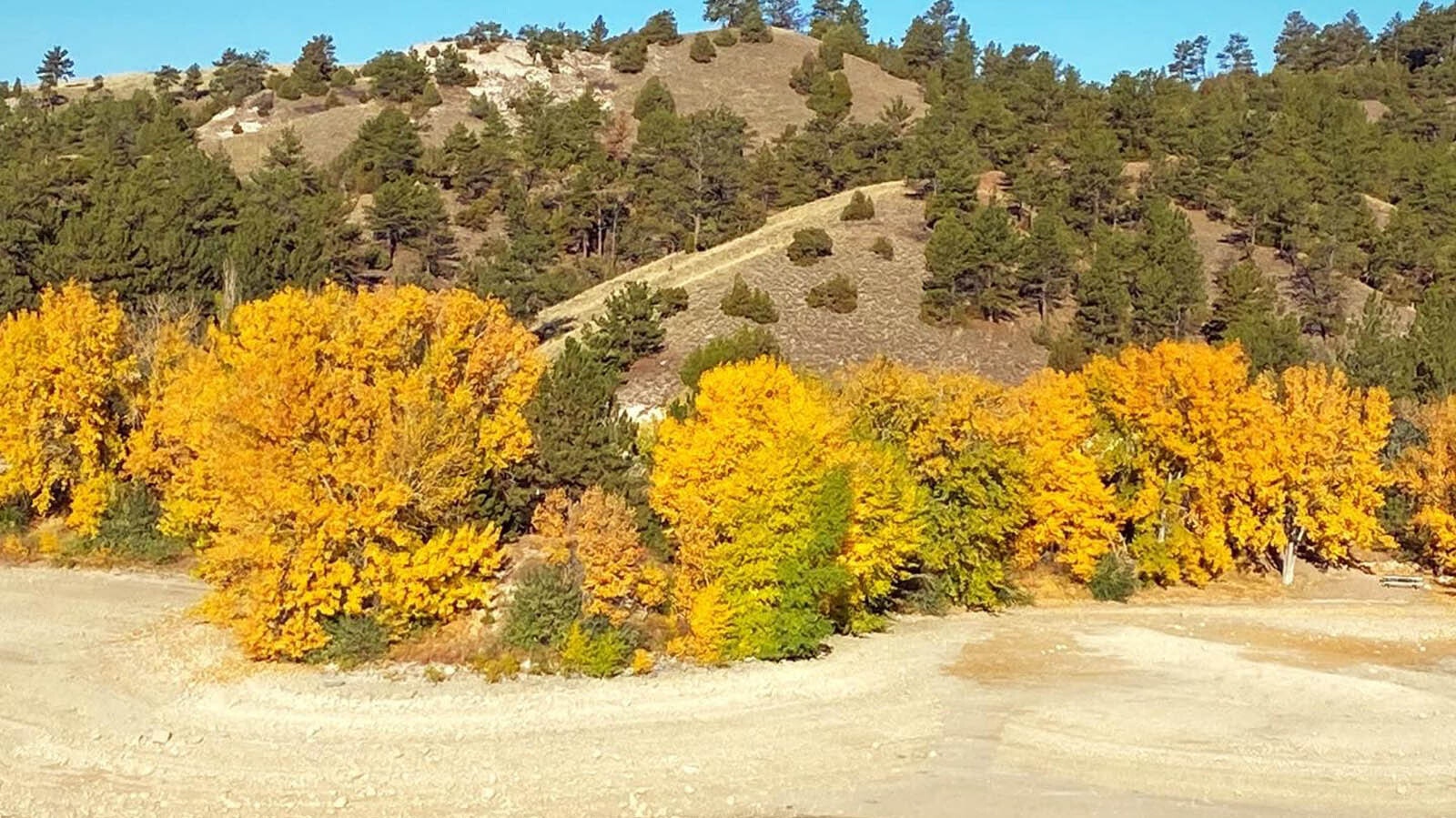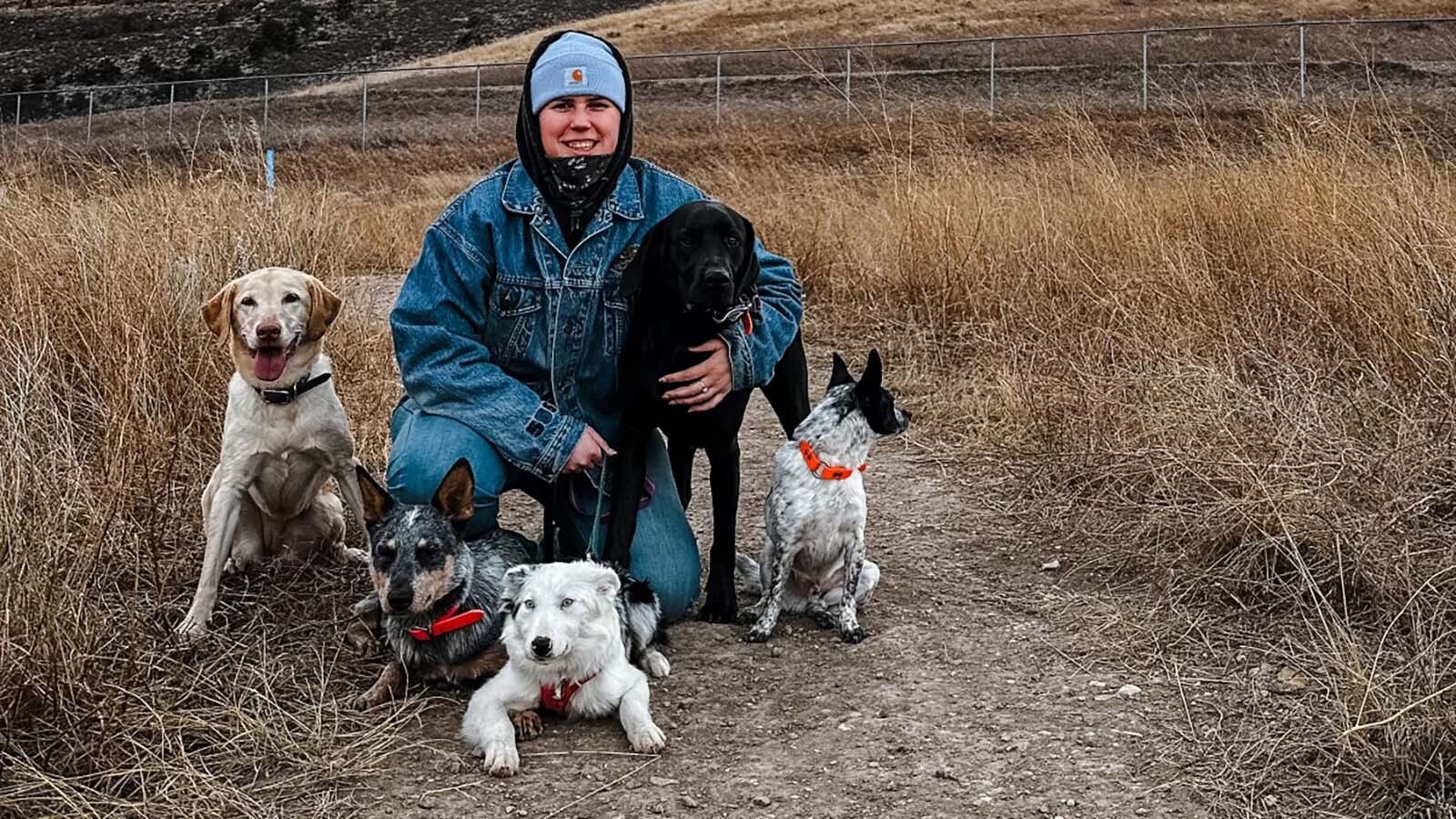By Renée Jean, Tourism and Business Reporter
renee@cowboystatedaily.com
A combination of shorter, bright sunny days that are just cool enough have extended displays of fall colors across Wyoming.
Cowboy State Daily meteorologist Don Day said this year’s display has been one of the best he’s seen.
“I was just down in Torrington this morning driving back and, you know, just all the trees in town and the cottonwoods on the plains, along the rivers and everything has just been a memorable fall,” he said. “Not only did we have great displays in the mountains, which we always get, but to have the trees so colorful so long in the cities, that’s been a treat as well.”
The magic that’s created this unusually long and bright fall display is not going to last much longer.
“We’re kind of at the end,” Day said. “We’ve really got through, I would say Saturday, to enjoy it. After that, we’re going to see the type of weather change that’s going to cause snow, wind and colder temperatures, especially in some of the areas where the colors have been really good.”
Here’s a rundown of where to find some of the best fall color displays at state parks across Wyoming.


Sinks Canyon
“The Aspen are glowing, and they have been for about two weeks now,” said Angelina Stancampiano, an interpretive ranger for Wyoming State Parks. “They progress in colors on the higher elevations. Rich, full gold at the top, and then down here toward the office we have some that are still turning from green to yellow.”
Outlines of yellow have painted the landscape in abstract patterns, while lower vegetation is backing things up with more of a rusty color.
“Everyone here is remarking that it’s like the longest show of fall colors,” Stancampiano said.
Stancampiano recommends several areas in Sink Canyons, which is near Lander, for a fall picnic and said the Loop Road is still open.
“That goes up through forestry land and spits you out down by South Pass City, which still has some magnificent color, too.”
Stancampanio has been hiking the North Slope trail and taking photos there. The golden aspen leaves are scattered across grey boardwalks, making for a colorful, serene picture.
“That North Loop trail goes really high really quickly,” she said. “So, then you’re looking down at the canyon and you’re seeing like a yellow ribbon of aspen from afar.”

Glendo State Park
“It’s starting to look really good,” Glendo Park Superintendent Brian Johnson told Cowboy State Daily of the fall colors viewing. “The trees are turning a little bit later this year than what they have, but we’re starting to get those fall colors here.”
Johnson recommends the Lakeshore Drive on the west side of the campground for the best color.
“Many campgrounds, several parts of that get really close to the lake and the trees so that would be a good area,” he said.
The south end of the park, around Whiskey Gulch, is another good area.
“There’s some pine trees there, but there’s a lot of the cottonwoods, so you get a nice blend,” he said. “We’re getting yellows and gold. A whole lot of the color you’re going to get there is just the yellow and gold.”
There’s a road between Mule Hill and Whiskey Gulch that visitors can drive down between the tall trees, which arch over the road like a cathedral of gold in the sky.
At the end of that short drive there’s a campground, which makes a nice picnic spot.
Glendo also has just over 45 miles of mountain bike trails, some of which go down into the wetlands area, which is particularly nice now, Johnson said.
“By going down just below the dam or down by the power plants, there’s a trailhead taking off from that,” he said. “You can walk back around the dam, so you’re walking along the river there. You’re going to have a wide variety of trees down there and be able to see a lot of wildlife, a lot of birds on that.”
There’s also a fishing pier that makes for a particularly good fall photo opportunity, Johnson added.

Keyhole State Park
A beautiful blend of gold cottonwood and Ponderosa pine are what visitors will find in Keyhole State Park, which is on the western edge of the Black Hills between Sundance and Moorcroft in northeast Wyoming.
“It’s really, really nice,” Keyhole Park Superintendent Greg Devereaux told Cowboy State Daily. “The Volksmarch trail is a beautiful hike, and that’d be the way to go. You can see the whole lake in areas of it.”
There are picnic spots all the way, and there also are nice places along the lake to have a picnic.
Toward the end of the along Volksmarch trail is Rocky Point, which is close to Cottonwood.
The Volksmarch is a lesser-known trail, Devereaux said, but a hidden gem.
“We’d like to get more people walking on it, it is actually a very beautiful hike,” he said. “You can park your car up by the headquarters right in front and then walk out on the paved path, which will lead you right to the trail.”
Folks who come into the park from Pine Haven, meanwhile, might be particularly interested in Coulter Bay, Johnson suggested, which has a nice trail along the cliffs.

Guernsey State Park
In Southeast Wyoming, the colors are making a strong show as well, said Guernsey Park Superintendent Chris Delay.
“If you drive on the east side of the reservoir to Long Canyon campground, that’s just really pretty right now along the lake in the canyon,” he said.
There also are several good hiking trails that allow visitors to look down on the lake.
“Any of them on the west side would be great trails to hike,” Delay said.
There’s a “castle” at the park, which is really just a fancy picnic pavilion. There are spots to park there, and hikers can then find the Marsh Mountain Trail.
There also are other trails like Davis Bay and Brimmer Point to check out. Those who want a more challenging scenic hike could try Night Mountain Trail, which is a little steeper than the others.
Most of the trails are around 1.5 miles, Delay said, and perfect for a day trip.
The park is about 100 miles from Casper and 100 miles from Cheyenne. Restaurants in the area include Crazy Tony’s and Twisters.
Buffalo Bill State Park
This park is a best-kept secret in the state, Park Superintendent Jared Brinkerhoff told Cowboy State Daily. It’s surrounded by mountains, which now are crowned with all the colors of fall.
“A lot of folks will find us and say, ‘Hey, we didn’t know that you’re here, and this is pretty neat,’” Brinkerhoff said. “Then, they end up staying for a couple of weeks. The views that you get from the park itself with the reservoir and … you’re surrounded by mountains. When you’re here, you’ve got that in every direction.”
Pretty colors are everywhere a visitor looks in the park right now, Brinkerhoff said.
“Right there along the North Fork Highway in between the park office and the North Fork campground there’s a lot of good fall colors,” he said. “And then over on the south side of the reservoir off of lower South Fork Road right next to the bridge there’s a lot of pretty colors over there.”
Motorists may park near the gate, but should make sure not to block it. After that, they are invited to walk through the campground at will.
The park doesn’t have its own trail yet, though that is something they are working on for the future. It is, however, near several national forests that have trails, including Sheep Mountain Trailhead, which is adjacent to Buffalo Bill State Park’s Stagecoach Campground.
There’s also Four Bears Trailhead about 5 miles up the road from the park and Green Creek Trailhead out of Wapiti as well.

It May Seem Magical, But It’s All Science
Jessica Friis with Cheyenne Botanic Gardens told Cowboy State Daily that the colors people see this time of year in fall leaves are actually there year-round. They just need the right environment to shine through.
“As the chlorophyll goes out, some of those other pigments become more visible,” she said.
The change in color is triggered by the shorter days and cooler nights, but bright, sunny days help intensify the color, which this year is allowing for one last gasp of extra sugar production.
The yellows and oranges are caused by a chemical referred to as carotenoids — the same as is found in carrots — while reds come from anthocyanins, which also are found in foods like beets, according to Cheyenne Botanical Gardens founder Shane Smith.
“As chlorophyll breaks down, it sends that last load of sugar down into the stems and roots to support the trees through winter,” Smith said. “It also forms what’s known as a specialized set of cells between the stem of the leaf, which is called the petiole.”
That new, growing film of cells is called an abscission layer, and it is this that creates the disconnect that causes colorful leaves to fall. An early frost can stop that layer from growing. When that happens, a tree can’t let go of its leaves even though they’ve already died and turned brown.
The abscission layer is what makes leaves increasingly vulnerable to wind, which Wyoming usually has in abundance. An absence of strong wind has been a key ingredient in this year’s display, along with the lack of serious frost and snow cutting things short, said Day.
“La Niña’s tend to have warm falls and cold springs, and we’re kind of seeing that,” he said. “So, this is similar to what we had last fall, but we did have one of those snow events earlier in the month of October last year that kind of put an end to that. La Niña’s tend to have milder, warmer, drier fallow which is exactly what we’ve seen.”





